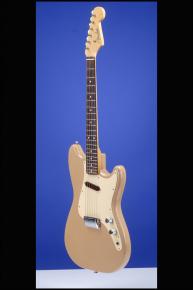A Fine and Original Early "Slab-Board" Musicmaster
This 12-inch-wide three-quarter size "student" guitar weighs just 5.90 lbs. and has a nut width of just under 1 9/16 inches and a short scale length of 22 1/2 inches. Solid alder body, one-piece maple neck with a medium to thin profile, and slab rosewood fretboard with 21 frets and clay dot position markers. Headstock decal with "Fender" logo in silver with black trim and "'Musicmaster'" in black below it. Single "butterfly" string tree. Individual single-line Kluson Deluxe tuners with white oval plastic buttons. Four-bolt neck plate with serial number ("38480") between the top two screws. One plain-top Bakelite Musicmaster pickup, angled at neck, with an output of 5.82k, plus two controls (one volume, one tone) and jack socket, all on the white plastic pickguard (with twelve screws). Telecaster-style chrome knobs with knurled sides and flat tops. Combined bridge/tailpiece with three adjustable threaded saddles. The neck is not dated. The pots are dated: "137 847" (CTS November 1958). Apart from some minor belt buckle scarring on the back of the body and a few small abrasions on the sides, this guitar is in exceptionally fine (9.00) condition. Complete with the original chrome bridge cover. Housed in the original Fender light tan hardshell case with tan leather ends and orange plush lining (9.00).
This fine and totally original ca. July 1959 Musicmaster has no neck date, as usual. "After April 1959, the [neck] dating procedure was temporarily suspended for several months and then resumed in early 1960. Rumour has it that FENDER stopped marking any date because someone complained about an obscene message penciled on the neck of his new guitar!" (A.R. Duchossoir, The Fender Stratocaster, p. 66).
"Fender's new 'student' guitars, the Duo-Sonic and Musicmaster, first appeared in 1956. They had smaller, lighter bodies, shorter necks and basic appointments. The Musicmaster was the single-pickup version...Despite their budget status, the student models were still playable instruments: Fender seemed to have cut the right corners" (Tony Bacon and Paul Day, The Fender Book, p. 29). Although Fender used the term "three-quarter size" in publicizing the new student models, only the neck and the resulting scale-length were smaller, designed for younger hands that were just starting to play guitar.
Translate:









